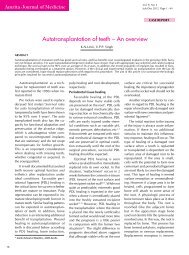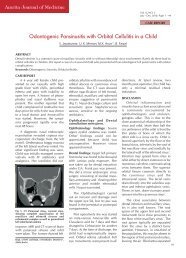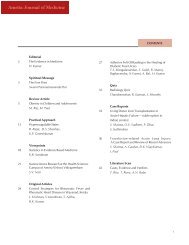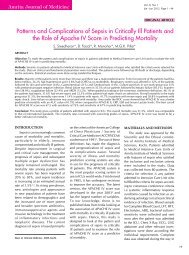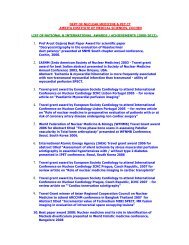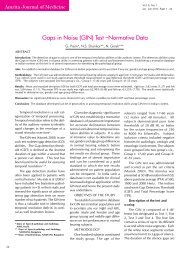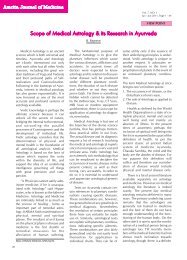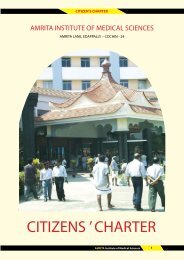Journal of Medicine Vol 4 - Amrita Institute of Medical Sciences and ...
Journal of Medicine Vol 4 - Amrita Institute of Medical Sciences and ...
Journal of Medicine Vol 4 - Amrita Institute of Medical Sciences and ...
You also want an ePaper? Increase the reach of your titles
YUMPU automatically turns print PDFs into web optimized ePapers that Google loves.
<strong>Amrita</strong> <strong>Journal</strong> <strong>of</strong> <strong>Medicine</strong><br />
Rhinocerebral Mucormycosis in a Patient with Diabetic Nephropathy<br />
the ethmoid sinuses to the frontal lobe results in<br />
obtundation. Spread from the sphenoid sinuses to the<br />
adjacent cavernous sinus can result in thrombosis <strong>of</strong> the<br />
sinus itself <strong>and</strong> involvement <strong>of</strong> the carotid artery.<br />
Isolated involvement <strong>of</strong> the Central Nervous System.<br />
Though central nervous system (CNS) infection typically<br />
arises from an adjacent PNS infection, there have<br />
been more than 30 cases <strong>of</strong> isolated CNS mucormycosis<br />
described in literature 4 . Over two-thirds <strong>of</strong> patients with<br />
isolated CNS mucormycosis have been intravenous drug<br />
abusers, who presumably have injected material contaminated<br />
with zygomycetes spores directly into the blood<br />
stream. Most <strong>of</strong> the patients presented with lethargy <strong>and</strong><br />
focal neurological deficits. The vast majority <strong>of</strong> patients<br />
had involvement <strong>of</strong> the basal ganglia although isolated<br />
involvement <strong>of</strong> the frontal lobe has also been described 4 .<br />
RENAL MUCORMYCOSIS<br />
Isolated involvement <strong>of</strong> the kidneys with mucormycosis<br />
has been reported <strong>and</strong> is presumed to occur via<br />
seeding <strong>of</strong> the kidneys during an episode <strong>of</strong> fungaemia 5 .<br />
Many <strong>of</strong> the patients with isolated renal involvement also<br />
are infected with human immunodeficiency virus. Patients<br />
with this form <strong>of</strong> mucormycosis usually present<br />
with flank pain <strong>and</strong> fever <strong>and</strong> involvement can be unilateral<br />
or bilateral 6 .<br />
MANAGEMENT<br />
The diagnosis <strong>of</strong> mucormycosis is made by identification<br />
<strong>of</strong> the organism in tissues with an inflammatory<br />
reaction <strong>and</strong> <strong>of</strong>ten necrosis <strong>of</strong> the tissue involved. A clinician<br />
must think <strong>of</strong> this entity <strong>and</strong> pursue invasive testing<br />
in order to establish a diagnosis as early as possible.<br />
Rhinocerebral infection should be suspected in any highrisk<br />
patient that presents with sinusitis. Though<br />
rhinocerebral mucormycosis has classically been associated<br />
with diabetic ketoacidosis, it can also occur in the<br />
absence <strong>of</strong> ketosis, as in this case. Endoscopic evaluation<br />
<strong>of</strong> the sinuses should be performed to look for tissue necrosis<br />
<strong>and</strong> to obtain specimens. The specimens should<br />
be inspected for hyphae using Calc<strong>of</strong>luor white <strong>and</strong><br />
methanamine silver stains. However the absence <strong>of</strong> hyphae<br />
should not dissuade clinicians from considering a<br />
diagnosis <strong>of</strong> mucormycosis when the clinical picture is<br />
highly suggestive.<br />
Further evaluation includes imaging <strong>of</strong> the head with<br />
either CT or MRI to gauge sinus involvement <strong>and</strong> to evaluate<br />
the contiguous structures <strong>of</strong> the brain. For isolated<br />
renal involvement, percutaneous biopsy or nephrectomy<br />
can establish a diagnosis 6 .<br />
The mainstay <strong>of</strong> treatment <strong>of</strong> mucormycosis is early<br />
surgical intervention, if this can be performed. Aggressive<br />
(<strong>of</strong>ten radical <strong>and</strong> disfiguring) surgical debridement<br />
should be undertaken as soon as the diagnosis <strong>of</strong> the<br />
rhinocerebral mucormycosis is strongly suspected. Adjunctive<br />
therapy with Amphotericin B (1mg/ Kg/day as<br />
IV infusions) is advised. Liposomal formulations have<br />
been used in some patients <strong>and</strong> this is indicated in patients<br />
intolerant to conventional Amphotericin B 7 .<br />
Despite early diagnosis <strong>and</strong> aggressive combined surgical<br />
<strong>and</strong> medical therapy, the prognosis for recovery from<br />
mucormycosis is not favourable. Absence <strong>of</strong> pulmonary<br />
involvement, surgical debridement, <strong>and</strong> a cumulative dose<br />
<strong>of</strong> Amphotericin-B more than 2000mg were associated<br />
with a better outcome 2 . In rhinocerebral mucormycosis,<br />
patients usually present with advanced disease <strong>and</strong> the<br />
prognosis is poor. The most significant factors associated<br />
with death were delayed diagnosis, the presence <strong>of</strong><br />
hemiplegia or hemiparesis, bilateral sinus involvement,<br />
leucopenia, renal disease <strong>and</strong> treatment with<br />
Desferoxamine 2 . Overall mortality from rhinocerebral<br />
mucormycosis ranges from 25 to 50 percent, with the<br />
best prognosis in patients with infection confined to the<br />
sinuses.<br />
As Physicians encounter <strong>and</strong> treat a large number <strong>of</strong><br />
diabetic patients with renal failure, as well as follow up<br />
renal transplant recipients (on immunosuppression), it<br />
would be essential to be fully aware <strong>of</strong> this fungal infection;<br />
a very early diagnosis <strong>and</strong> prompt treatment are<br />
extremely crucial to save the lives <strong>of</strong> these patients.<br />
REFERENCES<br />
1. Harril WC, Stewart MG, Lee AG, et al. Chronic Rhinocerebral<br />
Mucormycosis. Laryngoscope 1996;106:1292-97.<br />
2. McNulty JS. Rhinocerebral Mucormycosis: Predisposing factors.<br />
Laryngoscope 1982;92:1140-3.<br />
3. Radner AB, Witt MD, Edward JE. Acute Invasive rhinocerebral<br />
mucormycosis in an otherwise healthy patient. Case report <strong>and</strong><br />
review. Clin Infect Dis 1995;20:163-7.<br />
4. Hopkins RJ, Rothman M, Fiore A, et al. Cerebral mucormycosis<br />
associated with intravenous drug use. Three case reports <strong>and</strong><br />
review. Clin. Infect. Dis. 1994;19:1133-7.<br />
5. Langston C, Roberts DA, Porter GA, et al. Renal Phycomycosis.<br />
J Urol 1973;109:941-4.<br />
6. Levy E, Bia Mj. Isolated Renal Mucormycosis. Case report <strong>and</strong><br />
review. J. Am. Soc. Nephrol 1995;5:2014-7.<br />
7. Herbrecht R, Letscher – Bru V, Bowden RA. Treatment <strong>of</strong> 21<br />
cases <strong>of</strong> invasive mucormycosis with Amphotericin B colloidal<br />
dispersion. Eur. J. Clin. Microbiol. Infect. Dis. 2001;20:460-4.<br />
36



